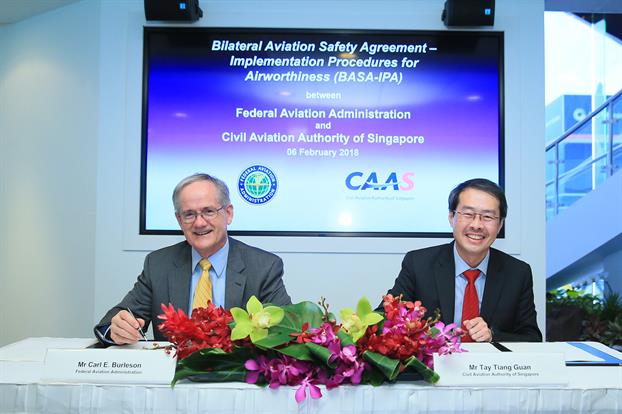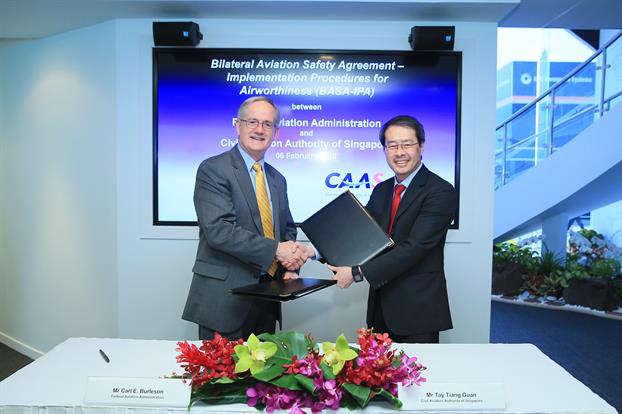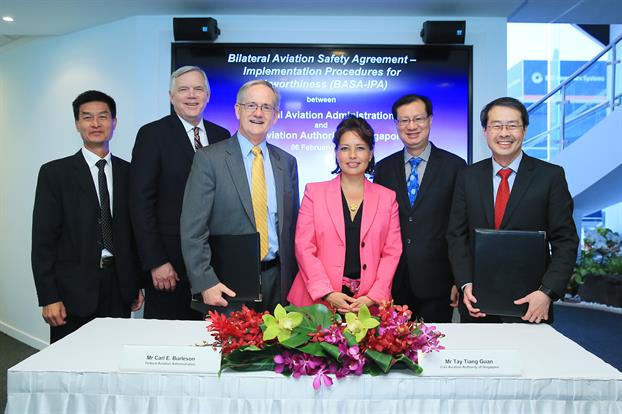The United States and Singapore Deepen Long-standing Bilateral Cooperation in Civil Aviation


(From left to right) Mr Carl Burleson, Acting Deputy Administrator, Federal Aviation Administration (FAA), and Mr Tay Tiang Guan, Deputy Director-General, Civil Aviation Authority of Singapore (CAAS), sign revisions to the Bilateral Aviation Safety Agreement - Implementation Procedures for Airworthiness (BASA-IPA) on the sidelines of the Singapore Airshow.

(From left to right) Mr Tan Kah Han, Senior Director (Safety Regulation) / Director (Airworthiness & Flight Operations), CAAS; Ambassador Thomas L. Carter, Representative of the United States on the Council of the International Civil Aviation Organization (ICAO); Mr Carl Burleson, Acting Deputy Administrator, FAA; Ms Stephanie Syptak-Ramnath, Chargé ďAffaires, ad interim, U.S. Embassy in Singapore; Mr Kevin Shum, Director-General, CAAS; Mr Tay Tiang Guan, Deputy Director-General, CAAS.
The U.S. Department of Transportation’s Federal Aviation Administration (FAA) and the Civil Aviation Authority of Singapore (CAAS) have deepened their long-standing cooperation in civil aviation by signing revisions to the Bilateral Aviation Safety Agreement – Implementation Procedures for Airworthiness (BASA-IPA) on the sidelines of the Singapore Airshow.
The enhancements follow upon the launch of the U.S. – Singapore Joint Aviation Steering Committee (JASC) in December 2017. The JASC is co-led by the FAA Administrator and the CAAS Director-General of Civil Aviation, to manage and strategically guide technical collaboration of aviation initiatives between FAA and CAAS in the areas of international aviation safety, regional cooperation and development, air traffic management, environment, and cybersecurity.
The enhanced BASA-IPA provides for the mutual recognition of airworthiness of civil aeronautical products, and includes an expanded scope of modifications and repairs allowed beyond that of cabin interiors. These enhancements will reduce duplicate certification activities for design approvals issued to air operators and aeronautical design industries from both the U.S. and Singapore, resulting in significant time and cost savings.
The BASA-IPA was originally signed in 2004 and later enhanced in 2007. At the Singapore Airshow 2016, FAA and CAAS expanded their cooperation with the conclusion of the BASA – Maintenance Implementation Procedures (MIP). Then in July 2017, both parties concluded the BASA-MIP Maintenance Agreement Guidance (MAG). The BASA-MIP allows for the reciprocal acceptance of safety oversight requirements, as well as the mutual recognition of procedures for the approval and monitoring of aircraft maintenance organisations. Similar to the BASA-IPA, the BASA-MIP significantly reduces regulatory burdens and compliance costs for the aviation industry.
“The FAA values our strong U.S. – Singapore bilateral relationship and we look forward to continued collaboration as we enhance our efforts this year through the development of the FAA-CAAS Joint Aviation Steering Committee,” said FAA Acting Deputy Administrator, Mr Carl Burleson.
Mr Tay Tiang Guan, Deputy Director-General of CAAS, added, “Through many years of working together, both sides have enjoyed a strong relationship anchored on mutual trust and confidence in technical competence. We are pleased that we have made significant breakthroughs in our bilateral arrangements in aviation safety. It is also a testament to the high safety standards we uphold, even as we seek to grow the aviation industry.”
"The removal of the limitations will now allow airlines to undertake a comprehensive supplemental type certificate package of modifications for cabin, mechanical and electrical systems, as well as the in-flight entertainment system. This will certainly help airlines reduce lead times and costs of cabin retrofit programmes," said Singapore Airlines Senior Vice President Engineering, Mr Lau Hwa Peng.
Dr Yip Yuen Cheong, Executive Vice President of Aerospace Engineering & Manufacturing, ST Aerospace, said, "We welcome the new revisions that simplify the process in getting the necessary certifications and approval from both the CAAS and FAA. Apart from lowering administrative costs, the revised agreement also helps in bringing to market new modification and repair solutions faster, which ST Aerospace will benefit from as we grow our engineering, design and manufacturing business in passenger-to-freighter conversions, cabin interiors and seats."
About the Civil Aviation Authority of Singapore
The mission of the Civil Aviation Authority of Singapore (CAAS) is to grow a safe, vibrant air hub and civil aviation system, making a key contribution to Singapore's success. CAAS' roles are to oversee and promote safety in the aviation industry, develop the air hub and aviation industry, provide air navigation services, provide aviation training for human resource development, and contribute to the development of international civil aviation.
About the Federal Aviation Administration
The Federal Aviation Administration (FAA) operates the safest, most efficient, and complex aerospace system in the world. The FAA employs more than 45,000 people globally who are dedicated to improving safety, efficiency, and environmental sustainability through global leadership, regulatory harmonization and partnerships. The FAA regulates the U.S. civil aviation industry and commercial space transportation, and is increasing safety and efficiency through its air traffic modernization program. Aviation contributes $1.6 trillion annually to the U.S. economy, supports 10.6 million jobs, and constitutes 5.1 percent of the nation’s gross domestic product.
For more information, please contact:
|
Michelle Teo Assistant Director, Corporate Communications Civil Aviation Authority of Singapore Email: michelle_teo@caas.gov.sg Tel: +65 6541 2086 Mobile: +65 9825 0982 |
|
Gregory Martin Assistant Administrator for Communications Federal Aviation Administration Email: Gregory.Martin@faa.gov Tel: 202-267-3883 |
 ) or https:// as an added precaution. Share sensitive
information only on official, secure websites.
) or https:// as an added precaution. Share sensitive
information only on official, secure websites.